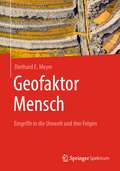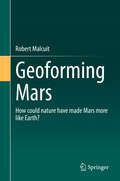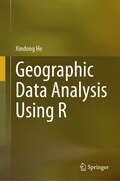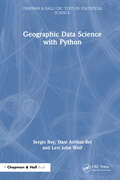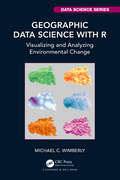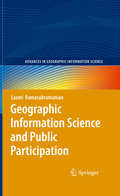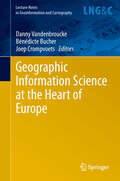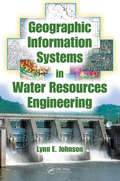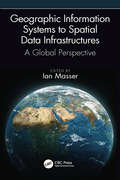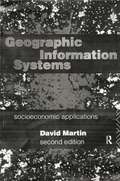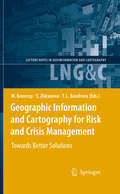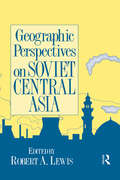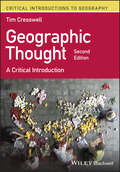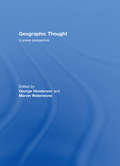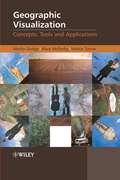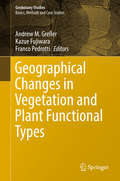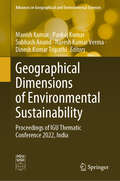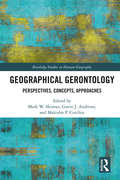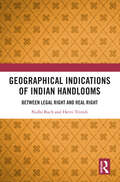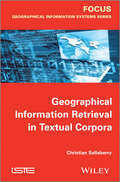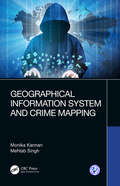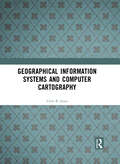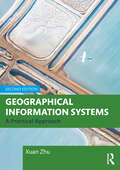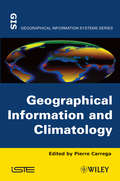- Table View
- List View
Geofaktor Mensch: Eingriffe in die Umwelt und ihre Folgen
by Diethard E. Meyer„Lässt sich die Erde retten? Sicherlich nicht mit einem neuen Buch wie diesem - aber es kann helfen, die Umweltprobleme besser zu verstehen!“ Der Aufstieg des Menschen zur wirksamsten geologischen Kraft auf dem Planeten Erde - kurz „Geofaktor Mensch“ genannt - vollzog sich allmählich. Im Industriezeitalter steigerte sich diese Kraft enorm durch neue Techniken. Diese ermöglichten die Inanspruchnahme fast sämtlicher Georessourcen für eine obendrein dramatisch anwachsende Menschheit, die weiterhin weltweit nach einem höheren Lebensstandard strebt. Kaum ein Gebiet der Erde bleibt verschont. Diese anthropogenen Eingriffe in das Naturgeschehen sind in vielfacher Hinsicht einzigartig - sowohl in ihrem Umfang als auch in ihrer Qualität. Seit kurzem wird dieser neuartige Zeitabschnitt in der Geschichte unseres Planeten als das „Anthropozän“ bezeichnet. Anschaulich und mit vielen Fotos und Diagrammen belegt dieses Werk das teilweise höchst komplexe Zusammenspiel der menschlichen Eingriffe in Natur und Umwelt. Zunächst schleichend, dann aber sehr plötzlich kann dieses an bestimmten „Kipp-Punkten“ zu anthropogen induzierten Katastrophen führen. Und genau diese gilt es von vornherein durch wissenschaftlich fundierte Planung unter strikter Kontrolle bei sich verändernden Rahmenbedingungen zu verhindern. Für Geowissenschaftler, Ökologen, Ingenieure und Landschaftsarchitekten sowie alle Tätigen in der Landschaftsplanung oder im Umwelt- und Naturschutz und nicht zuletzt die Entscheidungsträger in Politik und Wirtschaft vermittelt Geofaktor Mensch über das Orientierungswissen hinaus ein tieferes Verständnis der geologischen und ökologischen Prozesse. Diese zu kennen ist Voraussetzung für eine verlässliche Beurteilung des Systems der belebten Erde - der Geobiosphäre. Die zahlreichen Literaturhinweise ermöglichen eine gezielte Vertiefung der einzelnen Themen, besonders auch für Studierende.
Geoforming Mars: How could nature have made Mars more like Earth?
by Robert MalcuitThis book offers an exercise in theoretical planetology, presenting five different scenarios to assess the evolution of habitable conditions on Mars to assess planetary terraforming potential and to give insight into the ongoing search for habitable exoplanets. Four of the scenarios involve Martian satellite capture models, in which gravitational capture via tidal deformation and energy dissipation processes are measured to predict a pathway of biological evolution, while the fifth scenario analyzes the possible model that led to the Mars that we have today (i.e. with no life forms). In ten chapters, readers will learn how a Mars-like terrestrial planet can be transformed into a habitable planet, and what conditions must be assessed when searching for exoplanets in a star-centered orbit to support life. The book is intended for planetologists, and general enthusiasts of planetary evolution and our solar system.
Geographic Data Analysis Using R
by Xindong HeThis book is structured to encompass both the foundational and specialized aspects of quantitative analysis in geography. The basic content covers descriptive statistical analysis and correlation analysis of geographical data, while the professional content delves into more advanced topics like linear regression analysis, geographically weighted regression analysis, time series analysis, cluster analysis, principal component analysis, Markov chain analysis, and geographical network analysis. The methodologies span from widely utilized techniques to more recent developments, and the data primarily originates from reputable sources in China. The example code provided in the book can be executed using R packages available on the CRAN website.This book is an invaluable resource for undergraduate and graduate students, as well as researchers interested in learning and applying R for processing, visualizing, and analyzing geographic data. It serves as an introductory course in quantitative methods in geography for students in geography departments. Additionally, it is an ideal supplementary text for applied methods courses across various disciplines that involve geographic data, such as human and physical geography, geographic information science, ecology, public health, crime, and economics.
Geographic Data Science with Python (Chapman & Hall/CRC Texts in Statistical Science)
by Sergio Rey Dani Arribas-Bel Levi John WolfThis book provides the tools, the methods, and the theory to meet the challenges of contemporary data science applied to geographic problems and data. In the new world of pervasive, large, frequent, and rapid data, there are new opportunities to understand and analyze the role of geography in everyday life. Geographic Data Science with Python introduces a new way of thinking about analysis, by using geographical and computational reasoning, it shows the reader how to unlock new insights hidden within data. Key Features: ● Showcases the excellent data science environment in Python. ● Provides examples for readers to replicate, adapt, extend, and improve. ● Covers the crucial knowledge needed by geographic data scientists. It presents concepts in a far more geographic way than competing textbooks, covering spatial data, mapping, and spatial statistics whilst covering concepts, such as clusters and outliers, as geographic concepts. Intended for data scientists, GIScientists, and geographers, the material provided in this book is of interest due to the manner in which it presents geospatial data, methods, tools, and practices in this new field.
Geographic Data Science with R: Visualizing and Analyzing Environmental Change (Chapman & Hall/CRC Data Science Series)
by Michael C. WimberlyThe burgeoning field of data science has provided a wealth of techniques for analysing large and complex geospatial datasets, including descriptive, explanatory, and predictive analytics. However, applying these methods is just one part of the overall process of geographic data science. Other critical steps include screening for suspect data values, handling missing data, harmonizing data from multiple sources, summarizing the data, and visualizing data and analysis results. Although there are many books available on statistical and machine learning methods, few encompass the broader topic of scientific workflows for geospatial data processing and analysis. The purpose of Geographic Data Science with R is to fill this gap by providing a series of tutorials aimed at teaching good practices for using geospatial data to address problems in environmental geography. It is based on the R language and environment, which currently provides the best option for working with diverse spatial and non-spatial data in a single platform. Fundamental techniques for processing and visualizing tabular, vector, and raster data are introduced through a series of practical examples followed by case studies that combine multiple types of data to address more complex problems. The book will have a broad audience. Both students and professionals can use it as a workbook to learn high-level techniques for geospatial data processing and analysis with R. It is also suitable as a textbook. Although not intended to provide a comprehensive introduction to R, it is designed to be accessible to readers who have at least some knowledge of coding but little to no experience with R. Key Features: Focus on developing practical workflows for processing and integrating multiple sources of geospatial data in R Example-based approach that teaches R programming and data science concepts through real-world applications related to climate, land cover and land use, and natural hazards. Consistent use of tidyverse packages for tabular data manipulation and visualization. Strong focus on analysing continuous and categorical raster datasets using the new terra package Organized so that each chapter builds on the topics and techniques covered in the preceding chapters Can be used for self-study or as the textbook for a geospatial science course.
Geographic Information Science and Public Participation
by Laxmi RamasubramanianComputer-mediated participation is at the crossroads. In the early heady days of the digital revolution, access to "high" technologies such as GIS promised the empowerment of marginalized communities by providing data and information that was previously hidden away from public view. To a great extent, this goal has been achieved at least in the U.S. and Western Europe - data about a range of government initiatives and raw data about different aspects of spatial planning such as land use, community facilities, property ownership are available a mouse-click away. Now, that we, the public, have access to information, are we able to make better plans for the future of our cities and regions? Are we more inclusive in our planning efforts? Are we able to foster collaborative governance structures mediated by digital technologies? In the book, these issues will be discussed using a three-part structure. The first part of the book will be theoretical - it will review the literature in the field, establish a framework to organize the literature and to link three different subject areas (participation and community development, GIS and other related technologies, and planning processes). The second part of the book will be a series of success stories, case studies that review actual situations where participatory planning using GIS has enabled community wellbeing and empowerment. These case studies will vary in scale and focus on different planning issues (planning broadly defined). The final part of the book will step back to review alternative scenarios for the future, exploring where we are headed, as the technologies we are using to plan rapidly change.
Geographic Information Science at the Heart of Europe
by Joep Crompvoets Danny Vandenbroucke Bénédicte BucherFor the seventh consecutive year, the AGILE promotes the publication of a book collecting high-level scientific papers from unpublished fundamental scientific research in the field of Geographic Information Science. As the agenda for Europe 2020 is currently being set, this book demonstrates how geographic information science is at the heart of Europe. The contributions open perspectives for innovative services that will strengthen our European economy, and which will inform citizens about their environment while preserving their privacy. The latest challenges of spatial data infrastructures are addressed, such as the connection with the Web vocabularies or the representation of genealogy. User generated data (through social networks or through interactive cameras and software) is also an important breakthrough in our domain. A trend to deal more and more with time, events, ancient data, a nd activities is noticeable this year as well. This volume collects the 23 best full papers presented during the 16th AGILE Conference on Geographic Information Science, held between 14 and 17 May 2013 in Leuven, Belgium.
Geographic Information Systems in Water Resources Engineering
by Lynn E. JohnsonState-of-the-art GIS spatial data management and analysis tools are revolutionizing the field of water resource engineering. Familiarity with these technologies is now a prerequisite for success in engineers' and planners' efforts to create a reliable infrastructure.GIS in Water Resource Engineering presents a review of the concepts and application
Geographic Information Systems to Spatial Data Infrastructures: A Global Perspective
by Ian MasserThis book draws on author’s wealth of knowledge working on numerous projects across many countries. It provides a clear overview of the development of the SDI concept and SDI worldwide implementation and brings a logical chronological approach to the linkage of GIS technology with SDI enabling data. The theory and practice approach help understand that SDI development and implementation is very much a social process of learning by doing. The author masterfully selects main historical developments and updates them with an analytical perspective promoting informed and responsible use of geographic information and geospatial technologies for the benefit of society from local to global scales. Features Subject matter spans thirty years of the development of GIS and SDI. Brings a social science perspective into GIS and SDI debates that have been largely dominated by technical considerations. Based on a world-wide perspective as a result of the author's experience and research in the USA, Australia, Canada, Brazil, Peru, China, India, Korea, Malaysia, and Japan as well as most European countries. Draws upon professional and academic experience relating to pioneering UK and European GIS research initiatives. Includes updated historical material with an analytical perspective explaining what was done right, and what didn't work.
Geographic Information Systems: Socioeconomic Applications
by David MartinThis second edition of Geographic Information Systems builds on the strengths of the first, and incorporates important recent advances in GIS development and major new socioeconomic datasets including new census data. Martin presents an accessible introduction to the history, principles and techniques of GIS, with a unique focus on socioeconomic applications. This non-technical volume addresses the needs of students and professionals who must understand and use GIS for the first time.
Geographic Information and Cartography for Risk and Crisis Management
by Temenoujka L. Bandrova Milan Konecny Sisi ZlatanovaCartography and geographic information (GI) are remarkably appropriate for the requirements of early warning (EW) and crisis management (CM). The use of geospatial technology has increased tremendously in the last years. ICT has changed from just using maps created in advance, to new approaches, allowing individuals (decision-makers) to use cartography interactively, on the basis of individual user's requirements. The new generation of cartographic visualizations based on standardisation, formal modelling, use of sensors, semantics and ontology, allows for the better adaptation of information to the needs of the users. In order to design a new framework in pre-disaster and disaster management safety/security/privacy aspects of institutions and citizens need to be considered. All this can only be achieved by demonstrating new research achievements, sharing best practices (e.g. in the health area) and working towards the wider acceptance of geospatial technology in society, with the help of education and media. This book will outline research frontiers and applications of cartography and GI in EW and CM and document their roles and potentials in wider processes going on in information/knowledge-based societies.
Geographic Perspectives on Soviet Central Asia
by Robert A. LewisIn a unique survey, based on new census data, Geographic Perspectives on Soviet Central Asia highlights the region's geographic, economic and ecological problems since 1945. Painting a grim picture, this book investigates how the combination of rapid population growth and declining per capita investment is causing economic conditions to slide in rural areas and encouraging an ecological catastrophe. The authors discuss the effects of low rural out-migration, and show that at current growth rates the rural working-age population will double with each generation. Unprecedented in a developed country, this is causing the region to become more rather than less rural. Soviet Central Asia is an area of low productivity, and the book considers the lack of support from Soviet central government to the region. Wishing to maximise their return to capital and labour, the government is concentrating its investment in the European West and directing insufficient funds for a growing workforce in Central Asia. Soviet Central Asia also faces grave ecological problems; the declining level of the Aral Sea, extensive soil salinization and water pollution, all largely due to past attempts at irrigation. The authors consider the effect of these disasters on the area, and look to future possibilities in this very important region of the world.
Geographic Thought: A Critical Introduction (Critical Introductions to Geography)
by Tim CresswellGeographic Thought An accessible and engaging introduction to geographic thought In the newly expanded Second Edition of Geographic Thought: A Critical Introduction, renowned scholar Tim Cresswell delivers a thoroughly up-to-date and accessible examination of the major thinkers and key theoretical developments in the field. Coverage of the complete range of the development of theoretical knowledge—from ancient geography to contemporary theory—appears alongside treatments of the influence of Darwin and Marx, the emergence of anarchist geographies, the impact of feminism, and myriad other central bodies of thought. This latest edition also includes new chapters on physical geography and theory, postcolonialism and decoloniality, and black geographies. The author emphasizes the importance of geographic thought and its relevance to our understanding of what it means to be human and to the people, places, and cultures of the world in which we live. This new edition contains: New examples throughout consisting of contemporary research from a wider range of geographical contexts and by geographers from diverse backgrounds Comprehensive explorations of physical geography that combine updated coverage from the first edition with brand new material Updated discussions of spatial science and quantitative methods that include considerations of the role of place and specificity in quantitative work In-depth examinations of the Anthropocene, the uses of assemblage theory, and the emergence of the GeoHumanities. Perfect for students of undergraduate and graduate courses in geographic thought, Geographic Thought: A Critical Introduction will also earn a place in the libraries of students and scholars researching the history and philosophy of geography, as well as practicing geographers.
Geographic Thought: A Praxis Perspective
by George Henderson Marvin WaterstoneWithout social movements and wider struggles for progressive social change, the field of Geography would lack much of its contemporary relevance and vibrancy. Moreover, these struggles and the geographical scholarship that engages with them have changed the philosophical underpinnings of the discipline and have inflected the quest for geographical knowledge with a sense not only of urgency but also hope. This reader, intended for advanced undergraduate and beginning graduate courses in Geographic Thought, is at once an analysis of Geography’s theoretical and practical concerns and an encounter with grounded political struggles. This reader offers a fresh approach to learning about Geographic Thought by showing, through concrete examples and detailed editorial essays, how the discipline has been forever altered by the rise of progressive social struggles. Structured to aid student understanding, the anthology presents substantive main and part introductory essays and features more than two dozen unabridged published works by leading scholars that emphatically articulate geographic thought to progressive social change. Each section is introduced with an explanation of how the following pieces fit into the broader context of geographic work amidst the socially progressive struggles that have altered social relations in various parts of the world over the last half-century or so. Doubly, it places this work in the context of the larger goals of social struggles to frame or reframe rights, justice, and ethics. Geographic Thought provides readers with insights into the encounters between scholarship and practice and aims to prompt debates over how social and geographical knowledges arise from the context of social struggles and how these knowledges might be redirected at those contexts in constructive, evaluative ways. The reader is unique not only in knowing Geographic Thought through its progressive political attachments, instead of through a series of abstract "isms", but in gathering together salient works by geographers as well as scholars in cognate fields, such as Nancy Fraser, Chantal Mouffe, Iris Marion Young, and Jack Kloppenberg, whose own engagements have proved lasting and influential. For researchers and students interested in the connections between theoretically informed work and the possibilities for bettering people’s everyday lives, this book provides an innovative and compelling argument for why Geographic Thought is valuable and necessary.
Geographic Visualization
by Martin Dodge Mary Mcderby Martin TurnerGeographic Visualization: Concepts, Tools and Applications is a 'state-of-the-art' review of the latest developments in the subject. It examines how new concepts, methods and tools can be creatively applied to solve problems relevant to a wide range of topics. The text covers the impact of three-dimensional displays on user interaction along with the potentialities in animation and clearly explains how to create temporally sensitive visualizations. It also explores the potential for handling mobile data and representing uncertainty; as well as the role of participatory visualization systems and exploratory methods.Hallmark Features: An introduction to the diverse forms of geographic visualization which draws upon a number of theoretical perspectives and disciplines to provide an insightful commentary on new methods, techniques and tools.Richly illustrated in full colour throughout, including numerous relevant case studies and accessible discussions of important visualization concepts to enable clearer understanding for non-technical audiences.Chapters are written by leading scholars and researchers in a range of cognate fields, including, cartography, GIScience, architecture, art, urban planning and computer graphics with case studies drawn from Europe, North America and AustraliaThis book is an invaluable resource for all graduate students, researchers and professionals working in the geographic information sector, computer graphics and cartography.
Geographical Changes in Vegetation and Plant Functional Types (Geobotany Studies)
by Kazue Fujiwara Franco Pedrotti Andrew M. GrellerThis book presents studies on current vegetation topics, from polar to tropical regions. It is a festschrift to mark the 70th birthday of Prof. Elgene O. Box, who has studied vegetation all over the world, both through fieldwork and modeling. It reflects a number of his interests, including basic ecological plant forms (cf ‘plant functional types’), temperate-zone forests, and evergreen versus seasonal patterns. Section 1 discusses the concept of vegetation series, while Section 2 has two global-scale chapters on plant functional traits and whether they are related more to climate or phylogeny. Section 3 has nine chapters focusing on vegetation history, regional vegetation, and how these have influenced current species organizations and distributions. Regions treated include Russia, China, the USA, Mexico and Mediterranean areas. Lastly, Section 4 addresses aspects of vegetation change and plant ecology. Every chapter in this unique book offers original ideas on the topic of vegetation, as the authors are assembled from a world-wide population of leading vegetational ecologists, whose interests range from local communities to global theoretical questions.
Geographical Dimensions of Environmental Sustainability: Proceedings of IGU Thematic Conference 2022, India (Advances in Geographical and Environmental Sciences)
by Manish Kumar Pankaj Kumar Subhash Anand Dinesh Kumar Tripathi Naresh Kumar VermaThis book presents selected papers from the International Geographical Union (IGU) Thematic Conference 2022, which was held at the Central University of Haryana, Mahendragarh, India, November 24–25, 2022. The theme of the conference was Sustainability, Future Earth, and Humanities: Opportunities and Challenges. Within the context of the physical environment, the book explores advanced research and innovative methodologies that illuminate significant discoveries pertaining to comprehensive perspectives on sustainability. Environmental sustainability is a critical global concern that revolves around the responsible use and preservation of natural resources to meet present needs without compromising the ability of future generations to meet their own needs. It encompasses various dimensions that impact the health and resilience of our planet. Geographical factors play a crucial role in determining the challenges and opportunities associated with sustainability, offering valuable insights into the interconnectedness between nature and society. These insights are fundamental to understand environmental sustainability including ecosystem diversity, climate and weather patterns, land use and urbanization, water resources, natural hazards and vulnerability, resource distribution, transportation and connectivity, coastal and marine environments, political and social boundaries, and environmental justice. Understanding and integrating these geographical dimensions into environmental sustainability initiatives can lead to more effective and context-specific strategies to safeguard our planet's health and promote a harmonious coexistence between nature and human society. It requires interdisciplinary collaboration, international cooperation, and a shared commitment to protect and nurture the Earth for current and future generations. This book covers a broad range of issues, with an emphasis on how to create a physically and socially sustainable environment. In addition, this book provides comprehensive investigations of a range of subjects, including climate change, environmental risk assessment, climatic hazards, resource exploration, water resource management, seismic analysis, green synthesis, ground thermal regime, and glacial dynamics, among others.
Geographical Gerontology: Perspectives, Concepts, Approaches (Routledge Studies in Human Geography)
by Malcolm P. Cutchin Mark W. Skinner Gavin J. AndrewsUnderstanding where ageing occurs, how it is experienced by different people in different places, and in what ways it is transforming our communities, economies and societies at all levels has become crucial for the development of informed research, policy and programmes. <P><P>This book focuses on the interdisciplinary field of study – geographical gerontology – that addresses these issues. With contributions from more than 30 leading geographers and gerontologists, the book examines the scope and depth of geographical perspectives, concepts and approaches applied to the study of ageing, old age and older populations. The book features 25 chapters organized into five parts that cover the field’s theoretical traditions and intellectual evolution; the contributions of key disciplinary perspectives from population geography, social and cultural geography, health geography, urban planning and environmental studies; the scales of inquiry within geographical gerontology from the global to the embodied; the thematic breadth of contemporary issues of interest that define the field (places, spaces and landscapes of ageing); and a discussion about challenges, opportunities and agendas for future developments in geography and gerontology. <P><P>This book provides the first comprehensive foundation of knowledge about the state of the art of geographical gerontology that will be of interest to scholars of ageing around the world.
Geographical Indications of Indian Handlooms: Between Legal Right and Real Right
by Nidhi Buch Hetvi TrivediThis book presents a comprehensive analysis of Geographical Indications (GI) in the Indian context with particular reference to the handloom sector. It discusses themes such as the rationale of GI as IP (intellectual property); the domestic position on GIs; GI protection under various international instruments; handlooms from Gujarat and their GI journey; the efficacy of GIs; and GI structure for handlooms. The volume fills the gap between law and policies and recommends the implementation of an efficient legal system. It highlights the status of Indian handlooms, a sector that represents the country’s cultural heritage and supports a range of livelihoods. We examine India’s GI protection system with its diverse cultures and explore how GI can help recognize, support and promote these products to bring socio-economic benefits. The work documents policy measures undertaken for the revival, restructuring and promotion of Indian handlooms and handicrafts, and will serve as an important intervention in Indian law on GI. An investigative study that evaluates the current law and policy on GI protection through detailed case studies and empirical research on select Indian handlooms, this book will be useful to scholars and researchers of geography, economics, development studies, sociology, law and public policy. It will also interest policymakers, legal practitioners, textile and handloom professionals, design and business administration institutes, media, arts and crafts museums and civil society organizations working on handlooms or in intellectual property.
Geographical Information Retrieval in Textual Corpora
by Christian SallaberryThis book addresses the field of geographic information extraction and retrieval from textual documents. Geographic information retrieval is a rapidly emerging subject, a trend fostered by the growing power of the Internet and the emerging possibilities of data dissemination.After positioning his work in this field in Chapter 1, the author makes proposals in the following two chapters. Chapter 2 focuses on spatial and temporal information indexing and retrieval in corpora of textual documents. Propositions for both spatial and temporal information retrieval (IR) are made. Chapter 3 tackles the use of generalized spatial and temporal indexes, which are produced from there in the framework of multi-criteria IR. Geographic IR (GIR) is discussed at length, since this IR combines the criteria of spatial, temporal and thematic research.The author provides a rich bibliographical study of the current approaches focused on the modeling and retrieval of spatial and temporal information in textual documents, and similarity measures developed thus far in the literature.The book concludes with a broad perspective of the remaining scientific challenges. Several areas of research are discussed, such as integration of a domain-based ontology, modeling of spatial footprints from the interpretation of spatial relation, and parsing of relations between features deemed relevant within a document resulting from a GIR process. Contents Foreword, Christophe Claramunt.1. Access by Geographic Content to Textual Corpora: What Orientations ?2. Spatial and Temporal Information Retrieval in Textual Corpora.3. Multicriteria Information Retrieval in Textual Corpora.4. General Conclusion. About the Authors Christian Sallaberry is currently Assistant Professor at the Law, Economics and Management Faculty in Pau, France. His current research interests are in the fields of geographical information retrieval (GIR) in textual corpora: spatial, temporal and thematic information recognition, analyzing, indexing and retrieval. He is interested in spatial, temporal and thematic criteria combinations within a GIR process.
Geographical Information System and Crime Mapping
by Mehtab Singh Monika KannanGeographical Information System and Crime Mapping features a diverse array of Geographic Information System (GIS) applications in crime analysis, from general issues such as GIS as a communication process, interjurisdictional mapping and data sharing to specific applications in tracking serial killers and predicting violence-prone zones. It supports readers in developing and implementing crime mapping techniques. The distribution of crime is explained with reference to theories of human ecology, transport network, built environment, housing markets, and forms of urban management, including policing. Concepts are supported with relevant case studies and real-time crime data to illustrate concepts and applications of crime mapping. Aimed at senior undergraduate, graduate students, professionals in GIS, Crime Analysis, Spatial Analysis, Ergonomics and human factors, this book: Provides an update of GIS applications for crime mapping studies Highlights growing potential of GIS for crime mapping, monitoring, and reduction through developing and implementing crime mapping techniques Covers Operational Research, Spatial Regression model, Point Analysis and so forth Builds models helpful in police patrolling, surveillance and crime mapping from a technology perspective Includes a dedicated section on case studies including exercises and data samples
Geographical Information Systems and Computer Cartography
by Chris B. JonesA concise text presenting the fundamental concepts in Geographical Information Systems (GIS), emphasising an understanding of techniques in management, analysis and graphic display of spatial information.Divided into five parts - the first part reviews the development and application of GIS, followed by a summary of the characteristics and representation of geographical information. It concludes with an overview of the functions provided by typical GIS systems. Part Two introduces co-ordinate systems and map projections, describes methods for digitising map data and gives an overview of remote sensing. Part Three deals with data storage and database management, as well as specialised techniques for accessing spatial data. Spatial modelling and analytical techniques for decision making form the subject of Part Four, while the final part is concerned with graphical representation, emphasising issues of graphics technology, cartographic design and map generalisation.
Geographical Information Systems and Computer Cartography
by Chris B. JonesA concise text presenting the fundamental concepts in Geographical Information Systems (GIS), emphasising an understanding of techniques in management, analysis and graphic display of spatial information.Divided into five parts - the first part reviews the development and application of GIS, followed by a summary of the characteristics and representation of geographical information. It concludes with an overview of the functions provided by typical GIS systems. Part Two introduces co-ordinate systems and map projections, describes methods for digitising map data and gives an overview of remote sensing. Part Three deals with data storage and database management, as well as specialised techniques for accessing spatial data. Spatial modelling and analytical techniques for decision making form the subject of Part Four, while the final part is concerned with graphical representation, emphasising issues of graphics technology, cartographic design and map generalisation.
Geographical Information Systems: A Practical Approach
by Xuan ZhuGeographical information systems (GIS) are powerful tools for reporting on the environment, natural resources and social and economic development; modelling the environmental, biophysical, social and economic processes; assessing environmental and social impacts; evaluating environmental, social and economic policies and actions and dissimilating spatial information. Geographical Information Systems: A Practical Approach provides the fullest available introduction to GIS and their environmental, social and economic applications. This new edition has been substantially revised and updated to incorporate the key developments in GIS technology and spatial data science and their applications that have taken place in recent years.The key features include: A comprehensive coverage of concepts, methods, techniques and tools in GIS for spatial data capturing, processing, visualisation, analysis, modelling and decision-making Incorporation of advanced machine learning techniques for spatial data analysis and modelling Extended coverage of spatial visualisation with 3D mapping and online mapping Weaving together of GIS theory and practice to help readers learn important GIS concepts and methods and develop their understanding through practicals with ArcGIS Pro or QGIS New and updated case studies illustrating the innovative use of GIS for a wide range of applications The second edition of this text continues to bring up-to-date GIS knowledge, tools and practices into one cohesive, comprehensive, concise and self-contained book which is accessible to students, scientists and practitioners in environmental science, earth science, geography, archaeology and other scientific studies that have a spatial dimension.
Geographical Information and Climatology (Wiley-iste Ser.)
by Pierre CarregaThis book includes two parts. The first part is more theoretical and general, and it covers fundamental principles: geospatial climate data measurement; spatial analysis, mapping and climate; geographical information, remote sensing and climatology; and geographical information for initialisation of forecasting and climate models. The second part describes geographical information used in various climate applications of importance today, related to risk: urban climate; air pollution; hydrological problems linked to climatology; forest fires.
